How Do You Address PCB Contamination In Schools and Educational Facilities?
- Last Updated: June 12th, 2025

Attorney Jessie Paluch, founder of TruLaw, has over 25 years of experience as a personal injury and mass tort attorney, and previously worked as an international tax attorney at Deloitte. Jessie collaborates with attorneys nationwide — enabling her to share reliable, up-to-date legal information with our readers.
Legally Reviewed
This article has been written and reviewed for legal accuracy and clarity by the team of writers and legal experts at TruLawsuit Info and is as accurate as possible. This content should not be taken as legal advice from an attorney. If you would like to learn more about our owner and experienced injury lawyer, Jessie Paluch, you can do so here.
Fact-Checked
TruLawsuit Info does everything possible to make sure the information in this article is up to date and accurate. If you need specific legal advice about your case, contact our team by using the chat on the bottom of this page. This article should not be taken as advice from an attorney.
Key Takeaways:
- PCBs, or polychlorinated biphenyls, are hazardous substances often found in schools built before the 1980s. They can show up in caulking, light ballasts, electrical equipment, and old furniture.
- Exposure to PCBs can lead to serious health issues like cancer and learning disabilities for students and staff. The toxins also impact the community by contaminating local ecosystems through soil and water pollution.
- Maintenance staff should be trained on how to handle materials containing PCBs safely. Upgrading outdated electrical equipment and following environmental guidelines help keep school communities safe from exposure risks.
How to Address PCB Contamination in Schools and Educational Facilities
Question: How do you address PCB contamination in schools and educational facilities?
Answer: The Environmental Protection Agency (EPA) recommends several practical actions for addressing PCB contamination in schools and other buildings.
On this page, we’ll discuss this question in further depth, provide an overview of what PCB contamination is, potential health risks associated with PCB contamination, recommended steps to address this issue in schools, and much more.
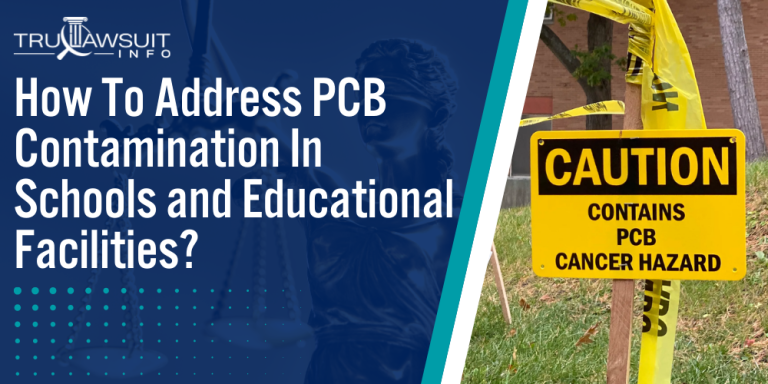
Intro to PCB Contamination in Schools
PCBs were potentially widely used in building materials in schools and other buildings built or renovated between 1950 and 1979.
If you or a loved one has experienced adverse health conditions after exposure to PCB chemicals, you may be eligible to pursue compensation.
Contact TruLawsuit Info today using the chat on this page to receive an instant case evaluation.
Table of Contents
Identification and Assessment of PCB Contamination
Before a school can address PCB contamination, it must first accurately identify and assess the presence and levels of PCBs within its facilities.
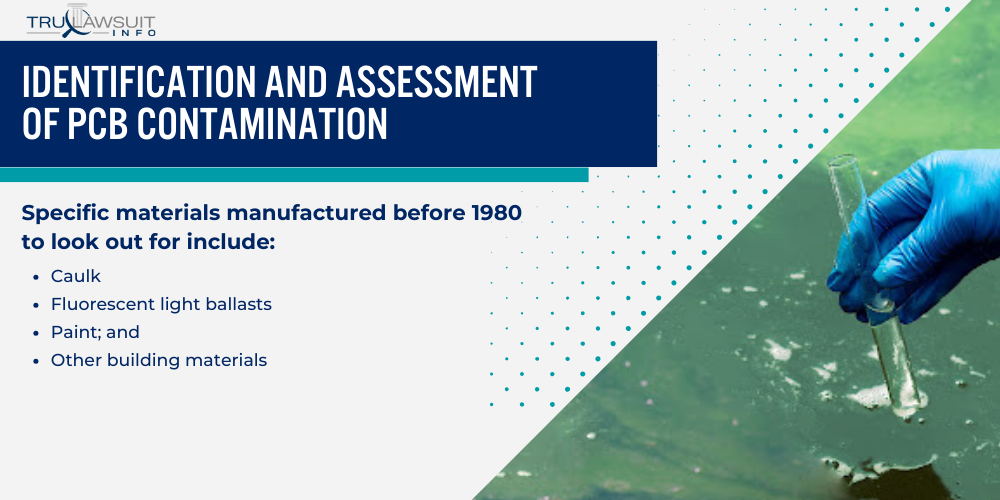
This section outlines the steps essential for a thorough evaluation.
Recognizing PCB Containing Building Materials in Schools
School buildings constructed or renovated prior to 1980 may have various building materials that contain PCBs.
Specific materials manufactured before 1980 to look out for include:
- Caulk
- Fluorescent light ballasts
- Paint; and
- Other building materials
Methods for Testing PCB Concentrations
To gauge the extent of PCB contamination, professionals employ a variety of tests.
These ensure accurate detection and measurement of PCB levels in the environment.
Testing for PCB concentrations involves a systematic approach using scientific methods:
- Air samples should be collected to assess indoor air quality for PCB presence.
- Surface swabs can detect PCBs on coating material surfaces like walls and floors.
- Bulk material samples may be taken from suspected PCB-containing materials.
- Deploying appropriate chemical analysis, such as gas chromatography, to measure exact PCB levels.
Evaluating the Risk of PCB Exposure in Public Facilities
Recognizing the potential health risks associated with PFAS contamination from AFFF usage is crucial.
An evaluation of the risk posed by PCB exposure in educational facilities requires careful consideration of the following:
- Current PCB concentrations in air samples and materials
- The extent of PCB-contaminated materials in the school
- Potential paths of exposure for occupants
- Federal and state guidelines for acceptable PCB levels
Mitigation Strategies: Schools and Other Public Facilities
Mitigating PCB contamination in schools requires immediate action to reduce exposure, followed by systematic planning for long-term remediation.
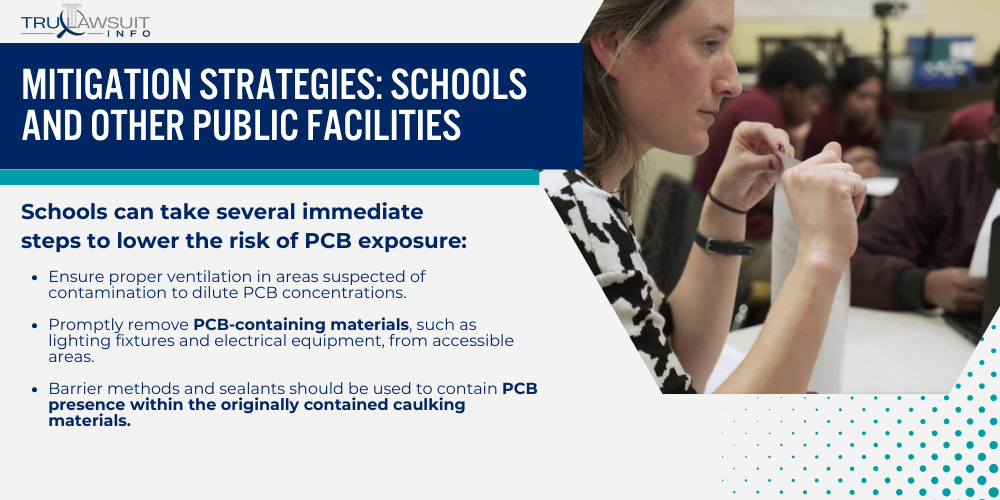
Schools and facilities must prioritize assessing the presence of PCBs and implementing measures to reduce exposure risks.
Immediate Measures to Reduce PCB Exposure
Reducing PCB exposure in public facilities is paramount to safeguarding public health.
Institutions can significantly mitigate the risks associated with harmful substances by adopting proactive measures, such as those recommended for PFAS.
Schools can take several immediate steps to lower the risk of PCB exposure:
- Ensure proper ventilation in areas suspected of contamination to dilute PCB concentrations.
- Promptly remove PCB-containing materials, such as lighting fixtures and electrical equipment, from accessible areas.
- Barrier methods and sealants should be used to contain PCB presence within the originally contained caulking materials.
- Implement clean-up procedures with materials that trap and remove PCBs without spreading the contamination.
Developing a PCB Remediation Plan
Developing a comprehensive plan for PCB remediation is crucial for long-term safety and compliance with environmental standards.
This involves detailed planning, engagement with environmental experts, and adherence to regulatory guidelines.
Key components of a successful PCB remediation plan include:
- Establishing a timeline and budget for the remediation process.
- Selecting certified contractors with experience in PCB removal.
- Regularly monitoring air and surface samples for PCBs during and after remediation.
- Communicating effectively with stakeholders, including school staff, parents, and regulatory bodies, about the risks and the steps being taken to mitigate them.
Mitigating PCB exposure in schools and public facilities is a large step toward safeguarding public health and ensuring a safe learning and working environment.
Materials and Waste Management
Managing materials and disposing of waste correctly are key steps in addressing PCB contamination.
These actions minimize the environmental impact and health risks of PCB waste:
- Segregate PCB waste materials from other types of waste to avoid cross-contamination.
- Store hazardous waste in well-labeled, secure containers to prevent leaks and inadvertent exposure.
- Dispose of PCB bulk product waste according to federal, state, and local regulations to ensure environmental safety.
- Record and track the disposal process for accountability and to provide clear documentation for regulatory compliance.
PCB Contamination Remediation and Cleanup
When addressing PCB contamination in schools and educational facilities, the focus must be on thorough remediation and cleanup to ensure a safe environment for students and staff.
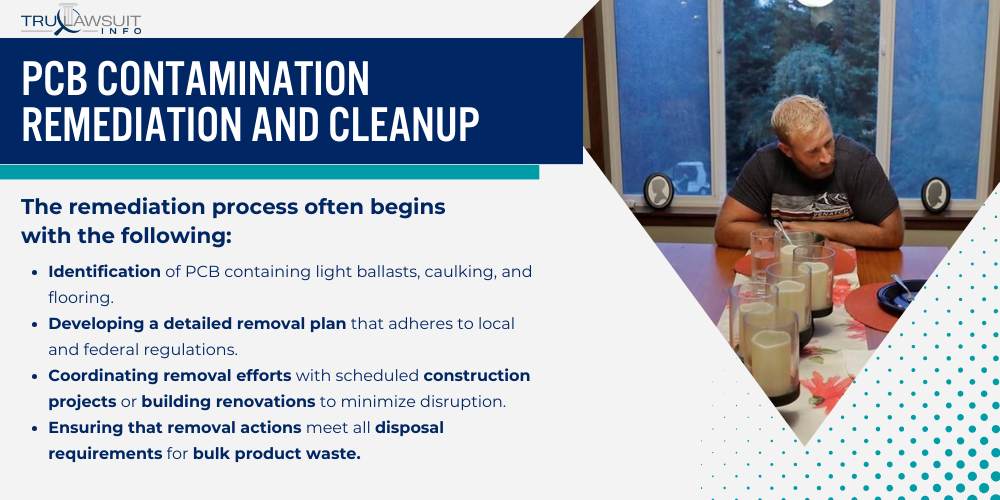
This involves specific procedures for removal and replacement, handling remediation waste, and setting up long-term monitoring and maintenance protocols.
Removal and Replacement Procedures
Addressing PCB contamination effectively begins with the identification and removal of PCB-containing materials.
This critical step ensures that sources of exposure are eliminated, safeguarding the health of the school community.
The remediation process often begins with the following:
- Identification of PCB containing light ballasts, caulking, and flooring.
- Developing a detailed removal plan that adheres to local and federal regulations.
- Coordinating removal efforts with scheduled construction projects or building renovations to minimize disruption.
- Ensuring that removal actions meet all disposal requirements for bulk product waste.
Handling PCB Remediation Waste
The proper handling of PCB remediation waste is paramount to the success of the cleanup effort.
Adhering to stringent regulations ensures the safe and effective disposal of contaminated materials, mitigating the risk of further environmental or health impacts.
Effective management of PCB waste is critical and must comply with stringent regulations:
- Segregation of PCB waste from other construction debris is crucial to prevent cross-contamination.
- Labeling and storage of PCB waste must meet specific disposal requirements.
- Transportation to a licensed facility that can handle PCB remediation waste.
- Documentation of all waste handling activities to track the significant clean-up costs associated with PCB disposal.
Long-Term Monitoring and Maintenance
After the initial cleanup efforts, institutions must establish a robust program dedicated to maintaining a PCB-free environment.
This continuous vigilance ensures that any potential re-emergence of PCBs is promptly addressed, safeguarding the health and safety of all occupants.
Post-cleanup, institutions must establish an ongoing program to maintain a PCB-free environment:
- Regular inspection of areas previously affected by PCBs.
- Monitoring air quality to detect any residual PCBs in the environment.
- Maintaining records of abatement activities and cleanup efforts.
- Implementing a communication plan to keep stakeholders informed about the status and results of PCB management efforts.
Implementing these meticulous procedures is vital for ensuring the health and safety of all individuals in educational facilities impacted by PCB contamination.
Regulation and Compliance: PCB Exposure Rates
Addressing PCB contamination in educational settings involves a rigorous understanding of the regulatory framework.
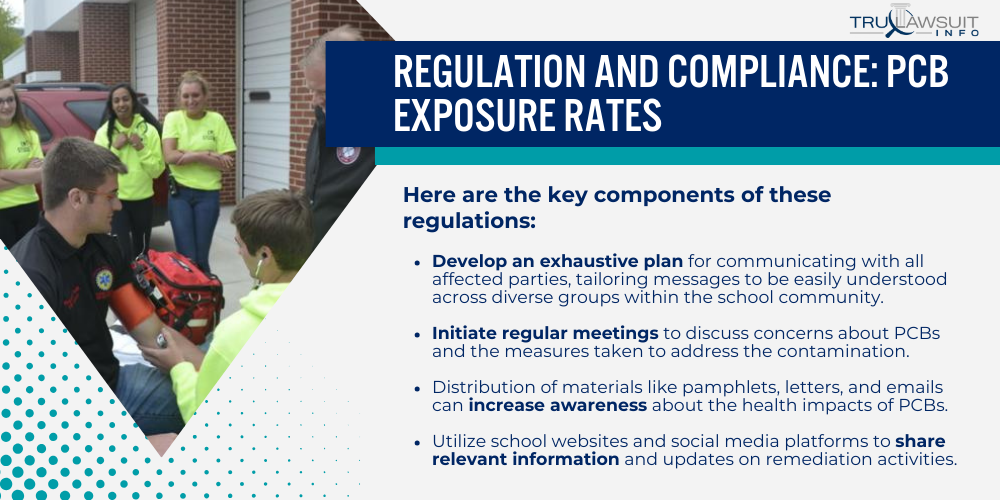
Ensuring compliance with federal standards is critical to safeguard health and safety.
Federal and EPA Regulations
The Environmental Protection Agency (EPA) has instituted specific regulations under the Toxic Substances Control Act (TSCA) to manage and reduce PCB exposure rates.
Here are the key components of these regulations:
- Comprehensive guidelines for the use, cleanup, and disposal of PCBs.
- Thresholds for PCB concentrations in school materials require action when levels are exceeded.
- Risk-based policies that aim to mitigate potential health risks associated with PCBs.
- Procedures for regular monitoring and reporting to ensure that schools remain within safety parameters.
Compliance for School Districts and Building Owners
School districts and building owners are tasked with the critical responsibility of ensuring that their facilities meet federal regulations.
To achieve this, school districts and building owners must consider the following key points:
- Conduct assessments to determine the PCB concentrations.
- Implement remediation plans for areas where PCB levels exceed federal guidelines.
- Maintain records of any PCB-related actions or abatement measures taken.
- Provide proper training to staff on managing and reducing PCB exposure in the facility.
By adhering to these regulatory requirements, school districts and building owners can significantly reduce health risks and ensure a safe learning environment.
Community Engagement and Support: Reducing PCB Exposure
Community involvement and professional guidance are crucial to reduce PCB exposure in schools and educational facilities.
Educating the school community and collaborating with experienced environmental professionals can lead to better environmental health outcomes.
Informing the School Community
To effectively safeguard our school community from the hazards of PCB exposure, it’s imperative to engage in open communication and education.
School administrators must inform and educate students, staff, and parents about PCB contamination and the potential risks it poses to public health:
- Develop an exhaustive plan for communicating with all affected parties, tailoring messages to be easily understood across diverse groups within the school community.
- Initiate regular meetings to discuss concerns about PCBs and the measures taken to address the contamination.
- Distribution of materials like pamphlets, letters, and emails can increase awareness about the health impacts of PCBs.
- Utilize school websites and social media platforms to share relevant information and updates on remediation activities.
- Organize informational workshops with guest speakers from the health or environmental sectors to address the concerns comprehensively.
- Implement educational campaigns aimed at students that inspire change in personal behaviors, such as proper hygiene practices in efforts to reduce exposure.
Working with Environmental Professionals
These specialists possess the knowledge and experience necessary to effectively address issues such as PCB contamination, ensuring a safe environment for students and staff.
To ensure a comprehensive approach to managing PCB contamination within school environments, consider the following steps:
- Secure services from qualified professionals specializing in environmental health and having a successful track record of managing PCB contamination.
- Have environmental experts conduct thorough site assessments to determine the extent of PCB impact.
- Collaborate with them to develop a customized cleanup and disposal program appropriate for the school setting.
- Ensure that ongoing monitoring and evaluation of PCB levels are in place to protect the school community continuously.
- Environmental experts should be part of the communication strategy to help clarify the technical aspects of PCB management.
- Foster partnerships with local health departments or environmental agencies that can provide support and additional resources for PCB remediation efforts.
Prevention and Building Maintenance: Avoiding PCBs at School
In addressing PCB contamination in schools, proactive prevention and building maintenance are crucial for creating safe educational environments.
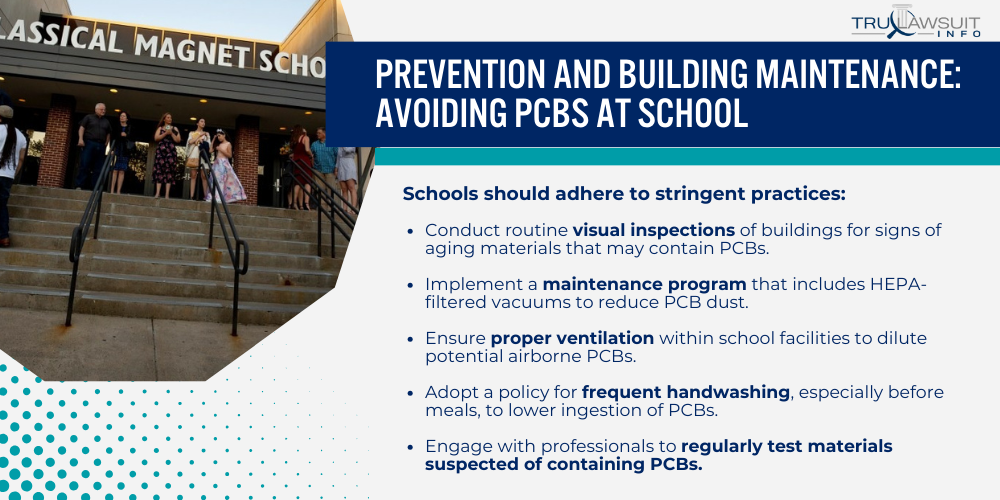
Best Practices for Ongoing PCB Management
Regular inspection and cleaning are at the forefront of managing PCB risks.
Schools should adhere to stringent practices:
- Conduct routine visual inspections of buildings for signs of aging materials that may contain PCBs.
- Implement a maintenance program that includes HEPA-filtered vacuums to reduce PCB dust.
- Ensure proper ventilation within school facilities to dilute potential airborne PCBs.
- Adopt a policy for frequent handwashing, especially before meals, to lower ingestion of PCBs.
- Engage with professionals to regularly test materials suspected of containing PCBs.
- Train custodial staff in PCB-safe cleanup procedures to prevent cross-contamination.
School administrators should prioritize these steps to mitigate the risk of PCB exposure.
Building Design and Construction Guidelines: Educational Facilities
Construction workers and designers play a pivotal role in preventing PCB contamination.
During construction or renovation, selecting building materials free of PCBs is essential:
- Prioritize using modern, PCB-free materials when selecting paints, sealants, and caulks.
- Integrate PCB considerations into building design to alleviate future contamination risks.
- Follow construction guidelines that specify materials certified as PCB-free.
- Document all materials used to ensure that records exist for future maintenance and inspections.
- Educate construction teams about the safe handling and disposal of PCB-containing materials.
- Enforce strict screening processes for all other buildings and materials entering the site.
Adherence to these guidelines can prevent PCBs from becoming problematic in new or renovated educational facilities.
Frequently Asked Questions
-
How can educational institutions identify and test for PCB presence in their facilities?
Educational institutions should hire professional environmental consultants to conduct PCB testing.
These specialists use methods such as air sampling and material testing to detect the presence of PCBs.
-
What are the EPA's guidelines for PCB remediation in school environments?
The EPA provides detailed guidelines for addressing PCB contamination.
They advocate for a proactive approach, including the removal and replacement of PCB-containing materials and the use of approved cleanup methods.
-
What are established best practices for PCB waste disposal in educational settings?
Best practices involve utilizing licensed hazardous waste disposal services.
Secure storage of PCB waste, accurate labeling, and proper transportation in compliance with EPA regulations are fundamental steps for disposal.
-
How does the PCB Mega Rule impact the management of PCBs in schools?
The PCB Mega Rule clarifies and updates regulations for handling PCBs.
This rule emphasizes stricter cleanup levels and more comprehensive disposal requirements, affecting how schools manage PCBs.
-
What practical measures can schools implement to prevent PCB contamination?
Schools should regularly clean with wet methods and HEPA-filtered vacuums to minimize dust.
They are also encouraged to replace old caulk and sealants, which might contain PCBs, and educate staff on PCB safety practices.

Experienced Attorney & Legal SaaS CEO
With over 25 years of legal experience, Jessie is an Illinois lawyer, a CPA, and a mother of three. She spent the first decade of her career working as an international tax attorney at Deloitte.
In 2009, Jessie co-founded her own law firm with her husband – which has scaled to over 30 employees since its conception.
In 2016, Jessie founded TruLaw, which allows her to collaborate with attorneys and legal experts across the United States on a daily basis. This hypervaluable network of experts is what enables her to share reliable legal information with her readers!
Have A Case?
Here, at Tru Lawsuit Info, we’re committed to helping victims get the justice they deserve.
To do this, we actively work to connect them with attorneys who are experts in litigating cases similar to theirs.
Would you like our help?
Tru Lawsuit Info is a reliable source of information about issues that may affect your health and safety, such as faulty products, data breaches, and environmental hazards.
Our team of experienced writers collaborates with medical professionals, lawyers, and advocates to produce informative articles, guides, and other resources that raise awareness of these topics.
Our thorough research provides consumers with access to reliable information and updates on lawsuits happening around the country. We also can connect consumers with attorneys if they need assistance.
Camp Lejeune's water contamination issue spanned several decades starting in the 1950s. Exposure to these chemicals has been linked to various serious health issues, including cancer, organ diseases, and death.
Research is increasingly suggesting a link between the use of Tylenol during pregnancy and the development of neurodevelopmental disorders, such as autism and ADHD, in infants.
Legal action is being taken against manufacturers of Aqueous Film-Forming Foam (AFFF), a chemical used in fighting fires. The plaintiffs allege that exposure to the foam caused health issues such as cancer, organ damage, and birth and fertility issues.
Have A Case?
Here, at Tru Lawsuit Info, we’re committed to helping victims get the justice they deserve.
To do this, we actively work to connect them with attorneys who are experts in litigating cases similar to theirs.
Would you like our help?







